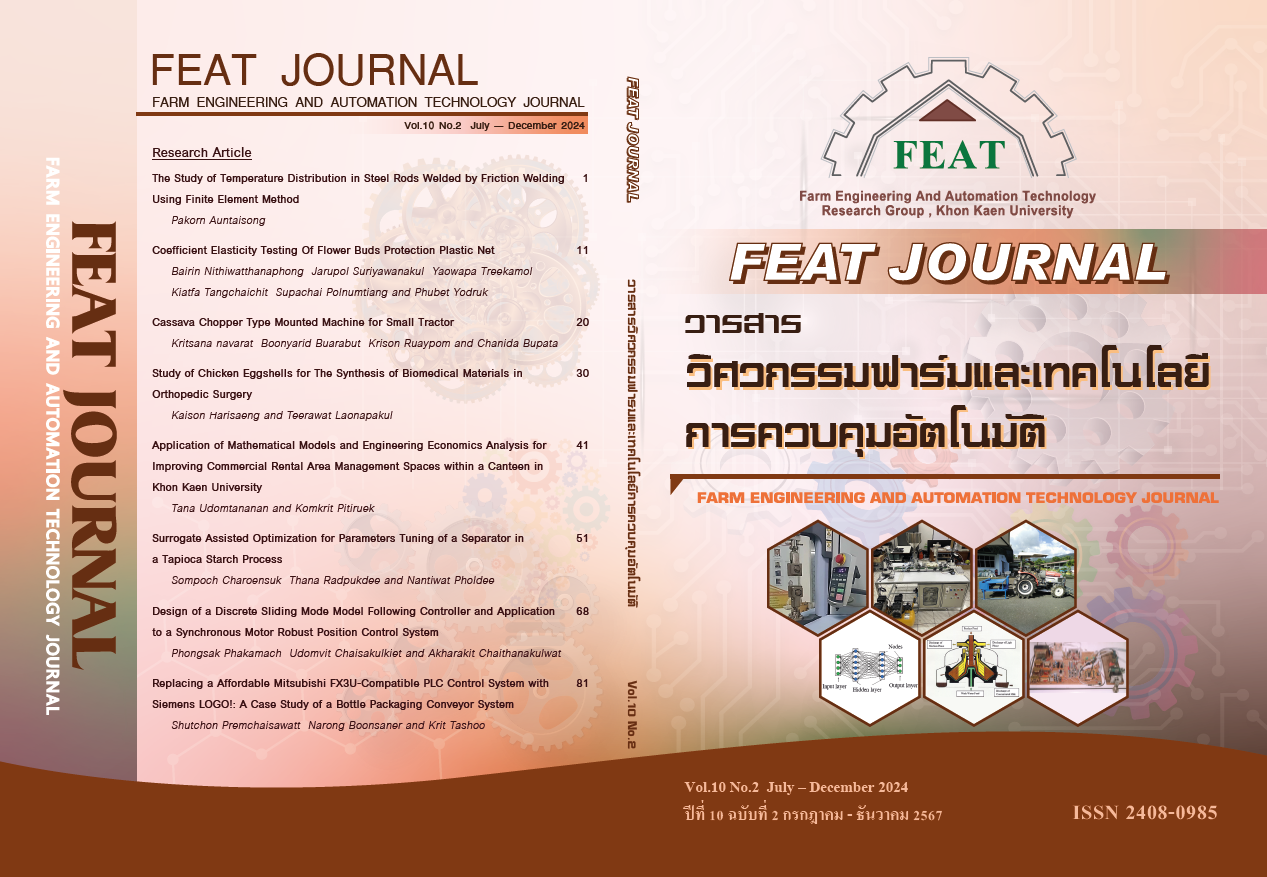การศึกษาการกระจายตัวของอุณหภูมิในเหล็กที่เชื่อมด้วยแรงเสียดทาน โดยวิธีไฟไนต์เอลิเมนต์
Main Article Content
บทคัดย่อ
งานวิจัยนี้เป็นการศึกษาการกระจายตัวของอุณหภูมิบริเวณรอยเชื่อมของเหล็กที่เชื่อมด้วยแรงเสียดทาน ขนาดเส้นผ่าศูนย์กลาง 15 mm ยาว 100 mm วัดอุณหภูมิห่างจากบริเวณรอยเชื่อม ที่ระยะ 5 mm และ 10 mm ตามลำดับ แล้วเปรียบเทียบผลกับแบบจำลองโดยวิธีไฟไนต์เอลิเมนต์ ที่มีพื้นฐานมาจากเอลิเมนต์รูปทรงสามเหลี่ยมและสี่เหลี่ยมแผ่นบาง ชนิด 2D Axisymmetric ซอฟแวร์ที่ใช้ คือ Abaqus16.4 เงื่อนไขที่ใช้ในการศึกษามี 2 เงื่อนไข และมีตัวแปรที่เกี่ยวข้อง 5 ตัวแปร ได้แก่ แรงดันเสียดทาน (bar) เวลาเสียดทาน (sec) แรงดันอัด (bar) เวลาอัด (sec) และความเร็วรอบ (rpm) โดยมีตัวแปรที่แตกต่างกัน คือ แรงดันเสียดทาน (bar) ในเงื่อนไขที่ 1 คือ 20 bar และเงื่อนไขที่ 2 คือ 30 bar จากผลการทดลอง พบว่า ค่าความคาดเคลื่อนระหว่างการทดลองและแบบจำลอง เงื่อนไขชุดที่ 1 ระยะ 5 mm อยู่ที่ 0.79% และระยะ 10 mm อยู่ที่ 3.58% และเงื่อนไขชุดที่ 2 ระยะ 5 mm อยู่ที่ 3.4% และระยะ 10 mm อยู่ที่ 5% จากการวิเคราะห์ผล พบว่า การเพิ่มแรงดันเสียดทานจาก 20 bar เป็น 30 bar ส่งผลให้อุณหภูมิเพิ่มขึ้นและกระจายตัวได้ดีขึ้น โดยแบบจำลองสามารถอธิบายการกระจายตัวของอุณหภูมิได้ ซึ่งให้ผลที่ใกล้เคียงและสอดคล้องกันกับการทดลอง
Article Details

This work is licensed under a Creative Commons Attribution-NonCommercial-NoDerivatives 4.0 International License.
วารสารวิศวกรรมฟาร์มและเทคโนโลยีควบคุมอัตโนมัติ (FEAT Journal) มีกําหนดออกเป็นราย 6 เดือน คือ มกราคม - มิถุนายน และกรกฎาคม - ธันวาคม ของทุกปี จัดพิมพ์โดยกลุ่มวิจัยวิศวกรรมฟาร์มและเทคโนโลยีควบคุมอัตโนมัติ คณะวิศวกรรมศาสตร์มหาวิทยาลัยขอนแก่น เพื่อเป็นการส่งเสริมและเผยแพร่ความรู้ ผลงานทางวิชาการ งานวิจัยทางด้านวิศวกรรมศาสตร์และเทคโนโลยีพร้อมทั้งยังจัดส่ง เผยแพร่ตามสถาบันการศึกษาต่างๆ ในประเทศด้วย บทความที่ตีพิมพ์ลงในวารสาร FEAT ทุกบทความนั้นจะต้องผ่านความเห็นชอบจากผู้ทรงคุณวุฒิในสาขาที่เกี่ยวข้องและสงวนสิทธิ์ ตาม พ.ร.บ. ลิขสิทธิ์ พ.ศ. 2535
References
Ramesh Kumar R, et al. Experimental and analytical investigation on friction welding dissimilar joints for aerospace applications. Ain Shams Engineering Journal 2023; 14(2), 1-17.
Ho Thi My N, et al. A Study on Rotary Friction Welding of Titanium Alloy (Ti6Al4V). Advances in Materials Science and Engineering 2019; 2019(1), 1-9.
Wen ya L, Fei fan W. Modeling of continuous drive friction welding of mild steel. Materials Science and Engineering A 2011; 528, 5921–5926.
Friction Welding: Principle, Working, Type, Application, Advantages and Disadvantages [Internet]. [cited 2017 April 6] Available from: URL: https://www.mech4study.com/ 2017/04/friction-welding-principle- working-types-application-advantages-and-disadvantages.html.
Eder Paduan A, et al. Experimental Thermal Analysis in Rotary Friction Welding of Dissimilar Materials. J Aerosp. Technol Manag 2019; 11(e4019): 1-9.
Jabbar Hassan A, et al. Experimental Investigation of Friction Pressure Influence on the Characterizations of Friction Welding Joint for AISI 316. International Journal of Engineering. IJE TRANSACTIONS C: Aspetcs 2020; 33(12), 2514-2520.
Xiawei Y, et al. Finite element modelling for temperature, stressesand strains calculation in linear friction welding ofTB9 titanium alloy. J m a t e r r e s t e c h n o l 2 0 1 9; 8(5), 4797–4818.
Seli H, et al. Evaluation of Properties and FEM Model of the Friction Welded Mild Steel - Al6061 - Alumina. Materials Research 2013; 6(2), 453-467.
Li W Y, et al. Heat reflux in flash and its effect on joint temperature history during linear friction welding of steel. International Journal of Thermal Sciences 2013; 67 (2), 192-199.
Kimura M, et al. Analysis Method of Friction Torque and Weld Interface Temperature During Friction Process of Steel Friction Welding. Journal of Solid Mechanics and Materials Engineering 2010; 4(3), 401-403.
ABAQUS Example problem guide, Volume I: Static and dynamic analysis; 2016.
Medhat Awad El-Hadek. Sequential Transient Numerical Simulation of Inertia Friction Welding Process. Proceedings of IMECE2008 ASME International Mechanical Engineering Congress and Exposition; 2008 Oct 31- Nov 6; Boston, Massachusetts, USA.

